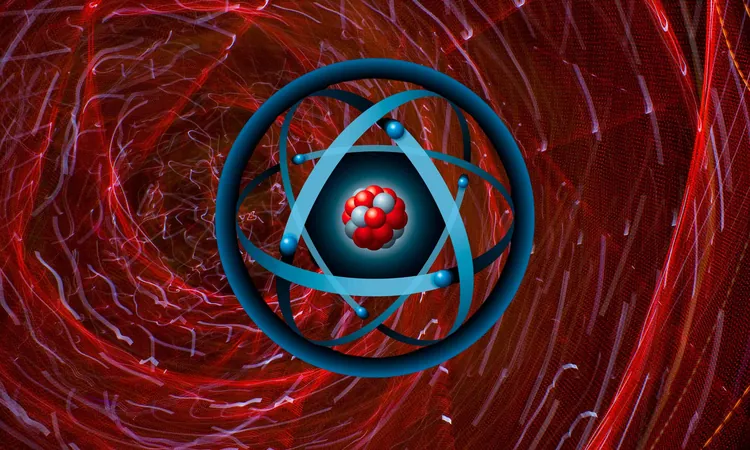
Groundbreaking Discovery: Scientists Capture the Shape of Electrons for the First Time!
2025-01-25
Author: Li
Groundbreaking Discovery: Scientists Capture the Shape of Electrons for the First Time!
In a stunning achievement that could revolutionize our understanding of quantum physics, researchers have successfully measured the shape of an electron as it traverses through solid materials. This remarkable discovery opens up new avenues in the way we comprehend electron behavior, with significant implications for fields ranging from quantum information science to the manufacturing of next-generation electronics.
Led by physicist Riccardo Comin, an associate professor at MIT, the research team worked in collaboration with various institutions to unveil a groundbreaking method of exploring electron properties. "We’ve essentially developed a blueprint for obtaining some completely new information that couldn't be obtained before," Comin stated, highlighting the transformative potential of their work.
A New Perspective on Electrons
For decades, scientists have scrutinized electrons, which exhibit both particle and wave-like characteristics, making their study complex. Electrons are more than mere points in space; they are described by "wave functions," which represent their state in higher-dimensional spaces. These wave functions can manifest as various shapes and forms, ranging from simple profiles to intricate, tangled geometries that pose challenges for measurement.
Utilizing a technique known as angle-resolved photoemission spectroscopy (ARPES), the team meticulously recorded how electrons behave when illuminated by light. This method enabled them to pinpoint a critical yet elusive characteristic of electrons—their geometry—providing a better grasp of their behavior inside materials.
Why Geometry Matters in Quantum Physics
Traditionally, discussions about electrons focused on familiar properties like energy and velocity. However, geometry reveals the patterns and formations that electron waves can adopt within solids. The geometry related to quantum mechanics plays a vital role in how electrons interact, pair, and exhibit exotic phenomena. For instance, superconductivity—a state wherein electrons flow through materials without resistance—is linked to these geometric properties.
By examining the geometry of electrons, scientists could pave the way for designing innovative materials with novel electronic characteristics.
Diving into Kagome Metals
The researchers explored the geometric attributes of kagome metals—materials featuring a distinctive lattice structure that resembles a network of interlocking triangles. This unique arrangement influences the movement and energy exchange among electrons, prompting behaviors that are not typically observed in other substances.
Kagome metals have intrigued physicists due to their capacity to demonstrate exceptional properties, including advanced superconductivity. By investigating the geometric configurations within these materials, researchers aim to elucidate why electrons organize in unusual ways that trigger such phenomena.
Harnessing Advanced Techniques
During ARPES experiments, researchers shine photons onto a crystal, causing the ejection of electrons, which they then analyze based on their angles and spins. This meticulous measurement process allows scientists to reconstruct the dynamics of electrons and discern their geometric shapes. Despite the complexity of the required equipment and the specialized facilities, the technique offers a unique opportunity to examine phenomena at scales smaller than a billionth of an inch.
Potential Applications and Future Directions
Understanding quantum geometry could lead to advancements in fields reliant on precise electron control, notably quantum computing, which necessitates stable electronic states for effective computation. By mastering electron geometry, researchers envision improvements in superconductors and the creation of energy-efficient electronic devices that minimize heat loss.
As energy efficiency becomes increasingly vital, mastering electron flow on such minute scales could prove invaluable in various technological domains.
Collaboration Across Borders
This remarkable study resulted from collaboration between institutions worldwide, combining theoretical and experimental expertise. The pandemic presented unique challenges, yet it also led to innovative adaptations as some researchers took on new roles in partially closed labs. This synergy between theory and experimentation was crucial for achieving high-precision measurements.
Unlocking the Secrets of Quantum Geometry
The findings confirm that quantum geometry is significantly more complex than conventional geometry. The intricate shapes of electron wave functions are far removed from simple geometric forms, resembling twists and loops in higher dimensions. Validating these theoretical predictions highlights the tangible implications of quantum mechanics.
With this substantial progression in measurement techniques, future studies may target exotic materials exhibiting unique patterns or behaviors. Scientists intend to refine ARPES and expand its application to various materials, examining how quantum geometry influences properties like conductivity and magnetism.
The search for ways to manipulate electron geometry to promote cooperative behavior among electrons is particularly promising. Such synchronization is critical for technologies dependent on the coordinated control of multiple electrons, including quantum sensors and memory devices.
Experts predict that these groundbreaking findings will spur more ambitious investigations into previously unmeasurable aspects of quantum geometry. With each discovery, researchers move closer to designing the electronic components of the future. Though electrons may be minuscule, they harbor secrets poised to shape the technological landscape of tomorrow.
The full study is published in the prestigious scientific journal Nature Physics, paving the way for an exciting future in quantum studies.
Stay tuned as we continue to unravel the mysteries of the quantum world!


 Brasil (PT)
Brasil (PT)
 Canada (EN)
Canada (EN)
 Chile (ES)
Chile (ES)
 Česko (CS)
Česko (CS)
 대한민국 (KO)
대한민국 (KO)
 España (ES)
España (ES)
 France (FR)
France (FR)
 Hong Kong (EN)
Hong Kong (EN)
 Italia (IT)
Italia (IT)
 日本 (JA)
日本 (JA)
 Magyarország (HU)
Magyarország (HU)
 Norge (NO)
Norge (NO)
 Polska (PL)
Polska (PL)
 Schweiz (DE)
Schweiz (DE)
 Singapore (EN)
Singapore (EN)
 Sverige (SV)
Sverige (SV)
 Suomi (FI)
Suomi (FI)
 Türkiye (TR)
Türkiye (TR)